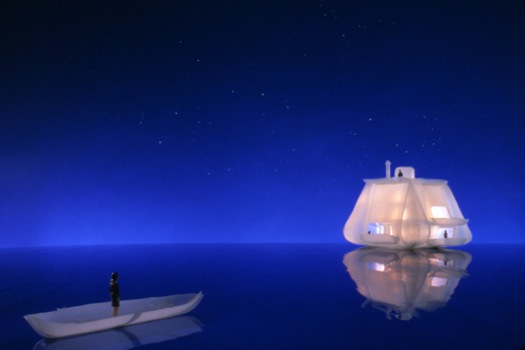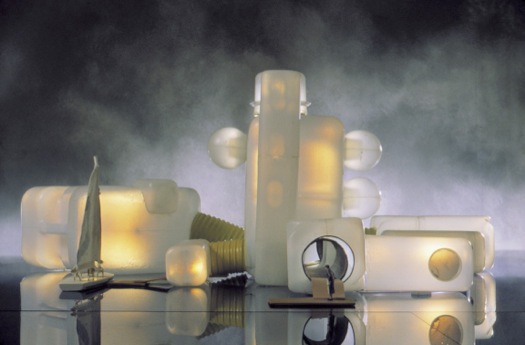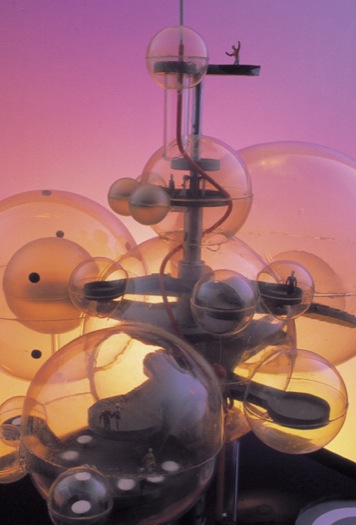
John Johansen, "Floating House"
In the span of a few cataclysmic days, architecture has lost two of its greatest visionaries. Lebbeus Woods died this past Tuesday, just as the flood waters of Hurricane Sandy were beginning to retreat from New York. He died in his sleep of natural causes, but his loft was without power, the city suffering from the kind of urban catastrophe that was the defining subject-matter of his work. (My obituary of Woods for Architectural Record is here.) Woods's death was preceded by that of John Johansen, the modernist pioneer and relentless searcher, who passed away at 96 a week earlier. The two shared a deep sense of humanism and a commitment to the practice of architecture as a social art.
Other than that, they could hardly have been more different. Woods's visions were dystopic evocations of a world scarred by violence. These were shaped by his personal history: his father, an air force officer, was present for the atomic testing at Bikini Atol and died from a rare form of leukemia. He had no illusions as to the dangers of the nuclear age. Johansen, by way of contrast, was a techno-utopian in the grand tradition of Bucky Fuller. It was through scientific progress—spray-form concrete, plastics, magnetic levitation, molecular engineering, nanotechnologiy—that he envisioned man's salvation.
Woods didn't build much at all, and when he did it was generally installation work. Johansen built a great deal. In the postwar years, as a member of the Harvard Five, he designed a series of homes in the New York suburbs. These limpid works broke with the rigid orthodoxy of the modern movement in their shapes and materials. Over the years, his work evolved, becoming more assertively physical. He will always be best known for his "brutalist" buildings, including the Mechanic Theater in Baltimore and the Mummers Theater in Oklahoma City, both now savagely faced with demolition. If they were "brutalist" there was also something essentially playful about them, with their pods and catwalks and other idiosyncracies. The work of Archigram was among his many inspirations—he was always open to the new. Until fairly recently he lived in a house of plastic tenting that he designed for himself a few hours from New York. His 1985 proposal for a Miami Beach Resort Hotel, with staggered pods in a pyramid-shaped framework, looks like something that might have popped off a drawing board at Bjarke Ingels's office last week.
I had the great privilege to know both Woods and Johansen, though not well. I was an editor at Princeton Architectural Press during the publication of several of Woods's books. He was always a charming and effusive presence. One morning during the making of Radical Reconstruction, he called in to have someone come pick up a series of corrected proofs and drawings from him at the Bowery Bar, where he had camped himself and was disinclined to move. I was alone—actually, it was the morning after Halloween—so I went. There were spooky decorations hanging from the ceiling, which I guess was appropriate. He offered me a beer and we talked for a bit, and then I raced back to the office through a drissle with his priceless portfolio. Months later there was a book party at the Cloud Club, at the top of the Chrysler Building, and he inscribed my copy of the finished book: "To Mark Lamster—architeture is a collaboration—thanks for your contribution."
My relationship with Johansen was a bit closer. In 2002, I commissioned a book of his futuristic projects, which I found endlessly charming and inspiring. His models, ostensibly illustrating the technologies of tomorrow, were constructed from plastic oddments and bric-a-brac he picked up at junk stores on Canal Street. Michael Moran shot these faux naive models from eye-level, with vivid backdrops that amplified their sense of whimsy and drama. Cornelia Blatter and Marcel Hermans of COMA created a modular book design that further accentuated their optimistic futurism. The excellent introduction was by Kevin Lippert, the publisher, his contribution indicative of the press's affection for the project. Johansen was nervous about the presentation, but he trusted our vision and there is no book of which I am more proud. When it was converted into an exhibition in the Netherlands, Johansen went along to lecture. He was very happy for the opportunity to preach his gospel to a new audience.
A few months ago I had reason to call Johansen. I wanted to interview him for my biography of Philip Johnson—they were classmates at Harvard's architecture school and friends in the years following. I knew this was going to be difficult, first because he was extremely deaf, but mainly because he had basically zero desire to talk about the past. He wanted, instead, to tell me about his ideas for nano-buildings and molecularly engineered architecture. It was that energy that kept him alive for so long, I suspect, and made him one of architecture's most persistent forces of optimism.
Several photographs from Nanoarchitecture follow, courtesy Michael Moran.

"Floating Conference Center"

"The Mag-Lev Theater"

"The Web"

"Froth of Bubbles"
